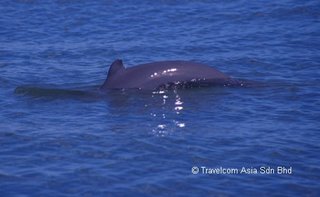
The Irrawaddy dolphin is found in tropical and sub-tropical waters of the Indo-Pacific region from eastern India to northern Australia. It generally inhabits shallow, inshore coastal waters and is often associated with river estuaries and mangrove forests. Irrawaddy dolphins are also found upstream in some major river systems in Southeast Asia, including the Mahakam River in Indonesia, the Mekong River of Cambodia, Laos & Vietnam and the Irrawaddy River in Myanmar, from which the species got its name.
A shy and elusive animal, the Irrawaddy dolphin has an unusual looking appearance, quite distinct from other oceanic dolphins. It has a blunt, rounded head, a flexible neck and a small triangular dorsal fin with a blunt tip. Their colour varies from dark grey to a light grey. The Irrawaddy is a relatively small dolphin with adults ranging between 2.1-2.6 metres in length and weighing between 90 and 150 kilograms. It feeds on fish, crustaceans and squid and generally remains within 2km of the coast.
The Irrawaddy is a slow moving dolphin. They normally only show the rear half of their bodies and hide their heads in the water as they surface for air. In general, each surface consists of a short blow and two or three slow rolls before diving. Occasionally, they show their tails before a dive. Irrawaddys usually swim around in groups of 2-6 individuals, however larger groups of up to 15 dolphins have been reported.
A shy and elusive animal, the Irrawaddy dolphin has an unusual looking appearance, quite distinct from other oceanic dolphins. It has a blunt, rounded head, a flexible neck and a small triangular dorsal fin with a blunt tip. Their colour varies from dark grey to a light grey. The Irrawaddy is a relatively small dolphin with adults ranging between 2.1-2.6 metres in length and weighing between 90 and 150 kilograms. It feeds on fish, crustaceans and squid and generally remains within 2km of the coast.
The Irrawaddy is a slow moving dolphin. They normally only show the rear half of their bodies and hide their heads in the water as they surface for air. In general, each surface consists of a short blow and two or three slow rolls before diving. Occasionally, they show their tails before a dive. Irrawaddys usually swim around in groups of 2-6 individuals, however larger groups of up to 15 dolphins have been reported.
Irrawaddy dolphins face a number of threats to their existence. Their preferred habitat of inshore waters is subject to intensive human activity and development pressures. They are therefore highly vulnerable to habitat destruction, pollution, boat collisions and entanglement in fishing nets.
2 comments:
sthenic to do something in order to establish an order governing the ways in which dolphins are used to attract tourists while avoiding the destruction of their environment
It is a beautiful creature
Post a Comment